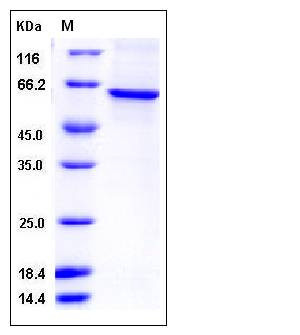Human TERF1 / TRF1 Protein (His Tag)
FLJ41416,hTRF1-AS,PIN2,t-TRF1,TRBF1,TRF,TRF1
- 100ug (NPP4302) Please inquiry
| Catalog Number | P13044-H07B |
|---|---|
| Organism Species | Human |
| Host | Baculovirus-Insect Cells |
| Synonyms | FLJ41416,hTRF1-AS,PIN2,t-TRF1,TRBF1,TRF,TRF1 |
| Molecular Weight | The recombinant human TERF1 consists of 438 amino acids and predicts a molecular mass of 50.5 kDa. It migrates as an approximately 60 kDa band in SDS-PAGE under reducing conditions. |
| predicted N | Met |
| SDS-PAGE |  |
| Purity | > 90 % as determined by SDS-PAGE |
| Protein Construction | A DNA sequence encoding the human TERF1 isoform 2 (NP_003209.2) (Met 1-Asp 419) was expressed, with a polyhistidine tag at the N-terminus. |
| Bio-activity | |
| Research Area | Cancer |Signal transduction |Other Related Intracellular Topics |Cellular Senescence and Pathways in Aging |Apoptosis |Nucleus | |
| Formulation | Lyophilized from sterile 20mM Tris, 500mM NaCl, pH 8.0, 10% gly 1. Normally 5 % - 8 % trehalose and mannitol are added as protectants before lyophilization. Specific concentrations are included in the hardcopy of COA. |
| Background | Telomeric repeat binding factor 1 (TRF1), also known as TERF1, the shelterin complex, which modulates the telomere structures. TRF1 protein structure contains a C-terminal Myb motif, a dimerization domain near its N-terminus and an acidic N-terminus. Pin2/TRF1 was originally identified as a protein bound to telomeric DNA (TRF1) and as a protein involved in mitotic regulation (Pin2). Pin2/TRF1 negatively regulates telomere length and importantly, its function is tightly regulated during the cell cycle, acting as an important regulator of mitosis. TRF1 can be bound and modulated by two nucleolar GTP-binding proteins, nucleostemin (NS) and guanine nucleotide binding protein-like 3-like (GNL3L), which exhibit apparently opposite effects on the protein degradation of TRF1. TRF1/TERF1 may has association with cancer. TRF1 may play a significant role in cell differentiation in non-small cell lung cancer (NSCLC). The expression level of TRF1 protein is significantly reduced in kidney cancer and the level is negatively correlated with malignant degree of the cancer. TRF1 expression in malignant gliomas cells, may play a role in the malignant progression of astroglial brain tumors. |
| Reference |
